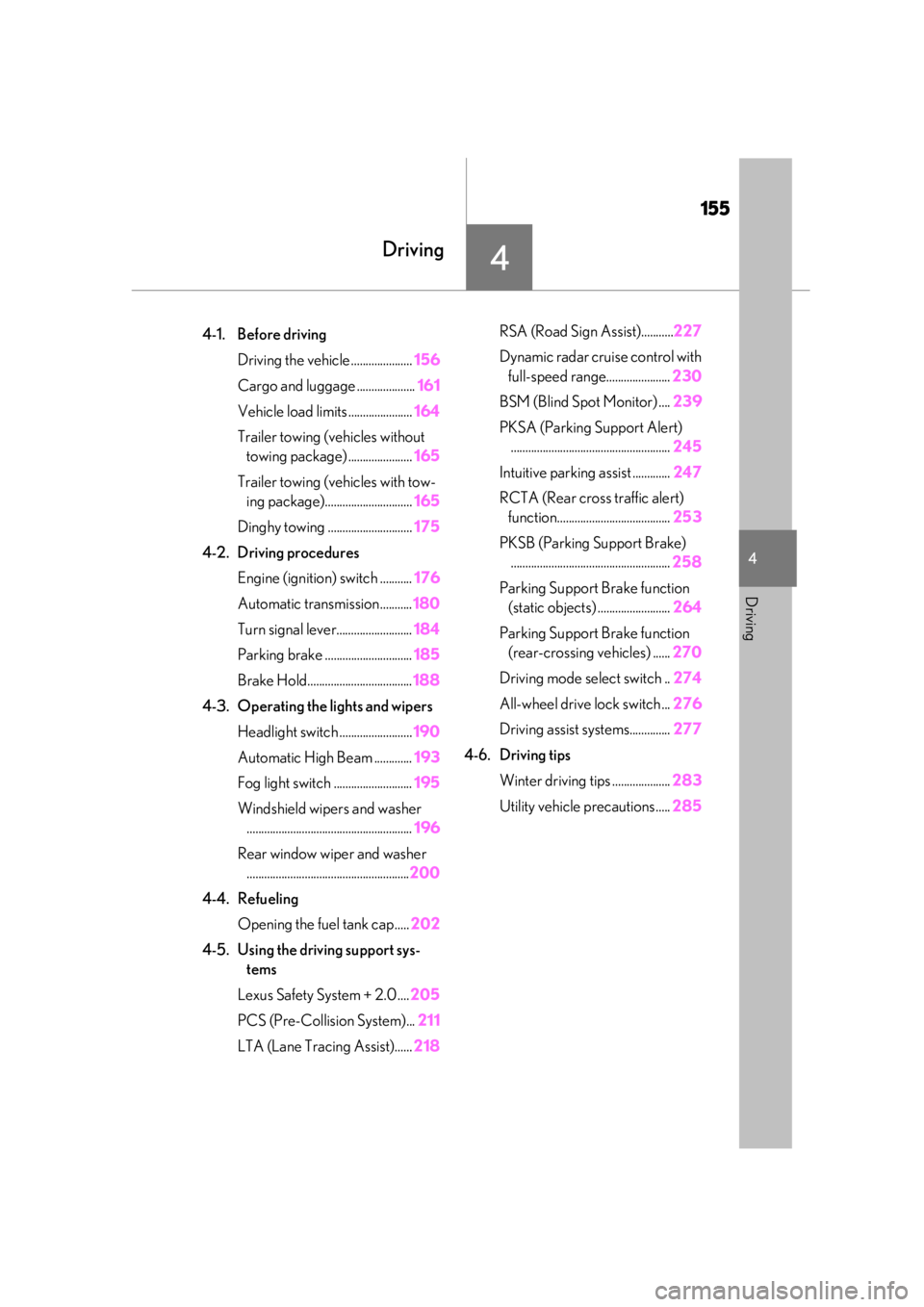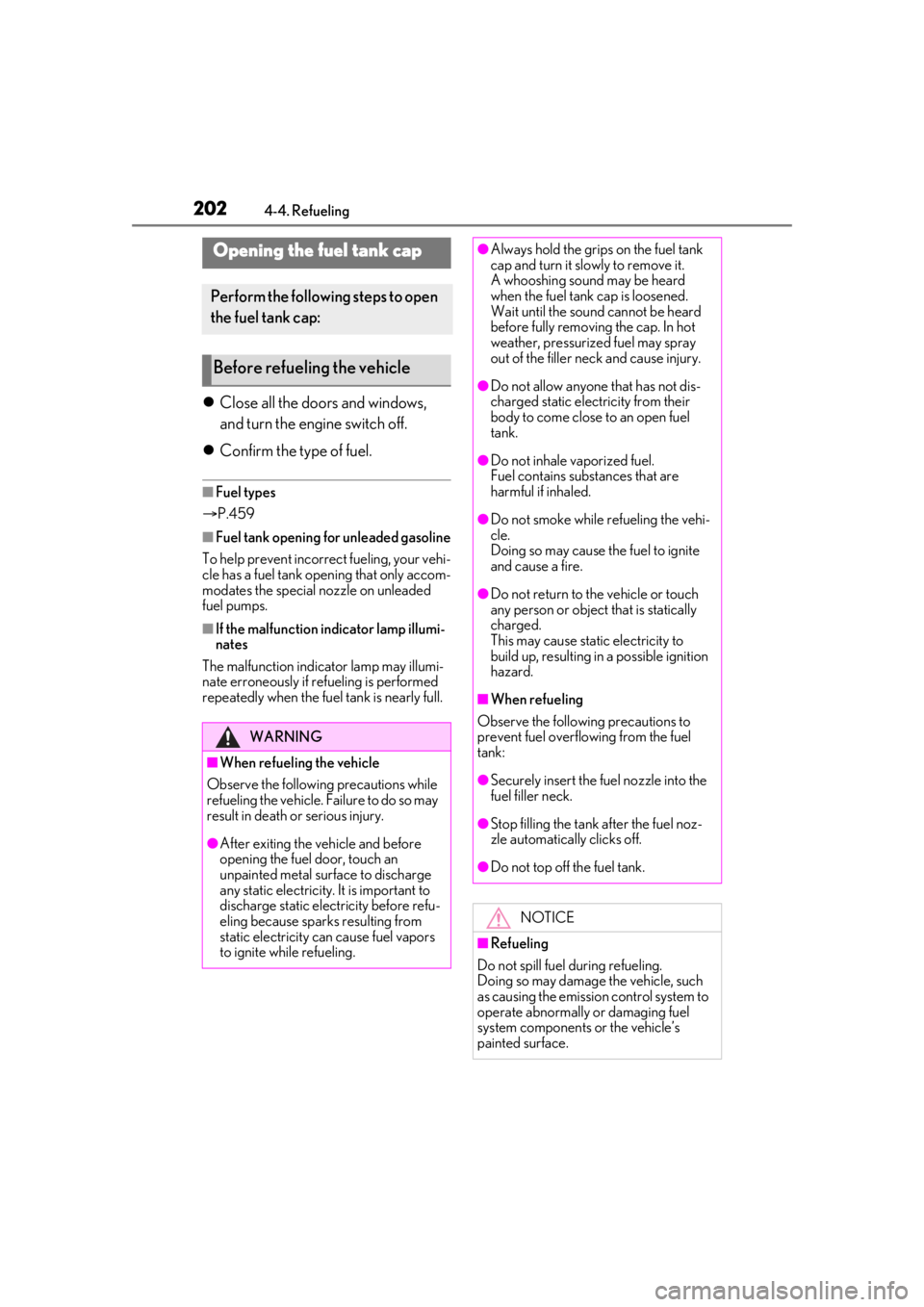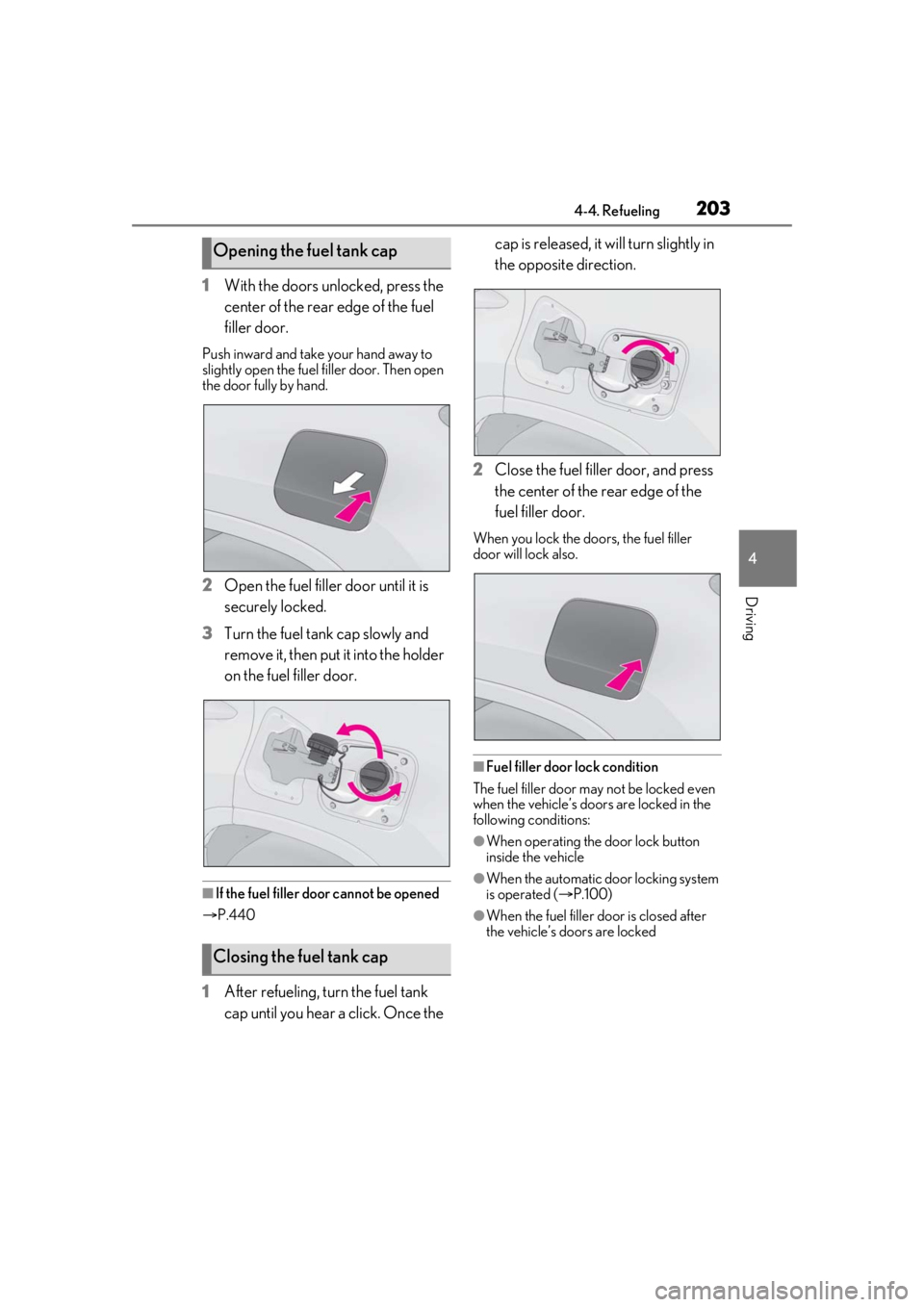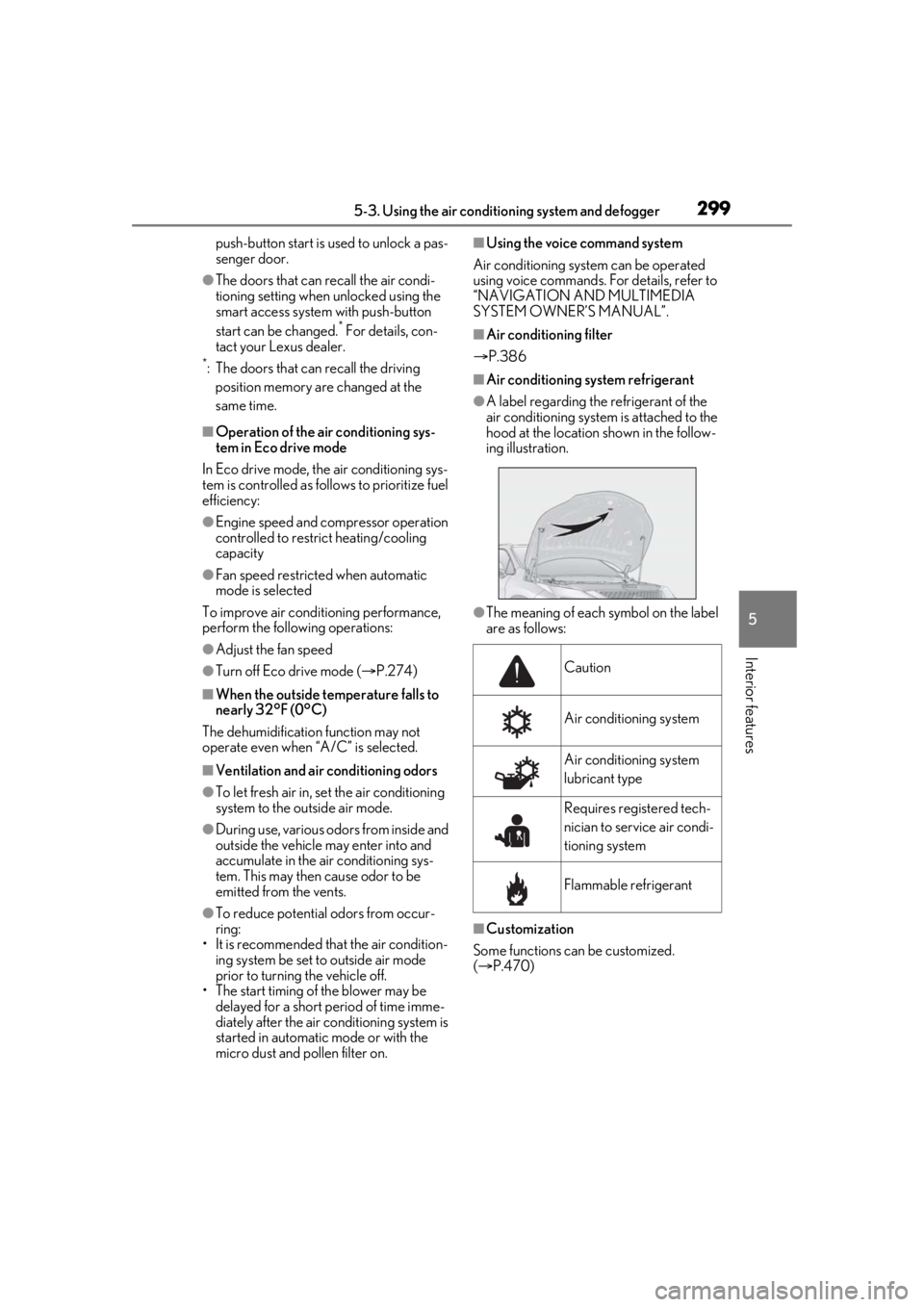2020 LEXUS RX350 fuel cap
[x] Cancel search: fuel capPage 3 of 516

3TABLE OF CONTENTS
1
2
3
4
5
6
7
8
9
Trailer towing (vehicles with towing package) ........................................ 165
Dinghy towing ................................ 175
4-2. Driving procedures Engine (ignition) switch .............. 176
Automatic transmission.............. 180
Turn signal lever............................. 184
Parking brake ................................. 185
Brake Hold....................................... 188
4-3. Operating the lights and wipers Headlight switch ............................ 190
Automatic High Beam ................ 193
Fog light switch .............................. 195
Windshield wipers and washer ............................................................ 196
Rear window wiper and washer ........................................................... 200
4-4. Refueling Opening the fuel tank cap........ 202
4-5. Using the driving support systems Lexus Safety System + 2.0 ....... 205
PCS (Pre-Collision System)...... 211
LTA (Lane Tracing Assist)......... 218
RSA (Road Sign Assist) ............. 227
Dynamic radar crui se control with
full-speed range......................... 230
BSM (Blind Spot Monitor) ....... 239
PKSA (Parking Support Alert) ........................................................... 245
Intuitive parking assist ................ 247
RCTA (Rear cross traffic alert) function .......................................... 253
PKSB (Parking Support Brake) ........................................................... 258
Parking Support Brake function (static objects) ............................ 264Parking Support Brake function
(rear-crossing vehicles) ......... 270
Driving mode select switch ......274
All-wheel drive lock switch...... 276
Driving assist systems ................. 277
4-6. Driving tips Winter driving tips ....................... 283
Utility vehicle precautions........ 285
5-1. Remote Touch/Display Remote Touch............................... 290
Center Display............................... 292
5-2. Lexus Climate Concierge Lexus Climate Concierge........ 295
5-3. Using the air conditioning system and defogger
Front automatic air conditioning
system ............................................ 296
Rear automatic air conditioning system ............................................ 307
Heated steering wheel/seat heat- ers/seat ventilators.................... 310
5-4. Using the interior lights Interior lights list ............................ 313
5-5. Using the storage features List of storage features ............... 316
Luggage compartment features ..........
................................................. 322
5-6. Using the other interior features Other interior features .............. 327
Garage door opener ................. 339
Compass ......................................... 346
5Interior features
Page 13 of 516

13Pictorial index
Precautions for winter season .....................................................................................P.283
To prevent freezing (windshield wiper de-icer)
*.................................................P.303
Precautions for car wash ................................................................................................ P.351
Fuel filler door ........................................................................................................ P.202
Refueling method ............................................................................................................. P. 202
Fuel type/fuel tank capacity ...... ................................................................................... P.454
Tires.......................................................................................................................... ... P.371
Tire size/inflation pressure ................................................................................. P.371, 457
Winter tires/tire chains ..................................................................................................P.283
Checking/rotation/tire pressure warning system................................................P.371
Coping with flat tires........................................................................................................ P .426
Hood ..........................................................................................................................P.363
Opening ........................................................................................................................ ....... P.363
Engine oil ..................................................................................................................... ......... P.454
Coping with overheating ............................................................................................... P.447
Warning messages .......................................................................................................... P.422
Headlights/front turn signal lights/front side marker lights ............ P.184, 190
Side turn signal lights .............................................................................................P.184
Parking lights/daytime running lights...............................................................P.190
Fog lights/cornering lights
*....................................................................... P.190, 195
Rear side marker lights .........................................................................................P.190
Stop/tail lights ..........................................................................................................P.190
Back-up lights/rear turn signal lights ...................................................... P.184, 190
Shifting the shift lever to R .............................................................................................. P.18 0
License plate lights .................................................................................................P.190
*:If equipped
Light bulbs of the exterior lights for driving
(Replacing method: P.394, Watts: P.458)
E
F
G
H
I
J
K
L
M
N
O
Page 155 of 516

155
4
4
Driving
Driving
.4-1. Before drivingDriving the vehicle ..................... 156
Cargo and luggage .................... 161
Vehicle load limits ...................... 164
Trailer towing (vehicles without towing package) ...................... 165
Trailer towing (vehicles with tow- ing package).............................. 165
Dinghy towing ............................. 175
4-2. Driving procedures Engine (ignition) switch ........... 176
Automatic transmission........... 180
Turn signal lever.......................... 184
Parking brake .............................. 185
Brake Hold.................................... 188
4-3. Operating the lights and wipers Headlight switch ......................... 190
Automatic High Beam ............. 193
Fog light switch ........................... 195
Windshield wipers and washer ......................................................... 196
Rear window wiper and washer ........................................................ 200
4-4. Refueling Opening the fuel tank cap..... 202
4-5. Using the driving support sys- tems
Lexus Safety System + 2.0 .... 205
PCS (Pre-Collision System)... 211
LTA (Lane Tracing Assist)...... 218RSA (Road Sign Assist)...........227
Dynamic radar cruise control with
full-speed range...................... 230
BSM (Blind Spot Monitor) .... 239
PKSA (Parking Support Alert) ....................................................... 245
Intuitive parking assist ............. 247
RCTA (Rear cross traffic alert) function....................................... 253
PKSB (Parking Support Brake) ....................................................... 258
Parking Support Brake function (static objects) ......................... 264
Parking Support Brake function (rear-crossing vehicles) ...... 270
Driving mode select switch .. 274
All-wheel drive lock switch ... 276
Driving assist systems.............. 277
4-6. Driving tips Winter driving tips .................... 283
Utility vehicle precautions..... 285
Page 157 of 516

1574-1. Before driving
4
Driving
●When the accelerator pedal is released
●When the brake pedal is depressed while
sport mode is selected
■Restraining the engine output (Brake
Override System)
●When the accelerator and brake pedals
are depressed at the same time, the
engine output may be restrained.
●A warning message is displayed on the
multi-information display and head-up
display (if equipped) while the system is
operating.
■Restraining sudden start (Drive-Start
Control)
●When the following unusual operation is
performed, the engine output may be
restrained.
• When the shift lever is shifted from R to D, D to R, N to R, P to D, or P to R (D
includes M) with the accelerator pedal
depressed, a warning message appears
on the multi-information display and
head-up display (if equipped). If a warn-
ing message is shown on the multi-infor-
mation display and head-up display (if
equipped), read the message and follow
the instructions.
• When the accelerator pedal is depressed
too much while the vehicle is in reverse.
●While Drive-Start Control is being acti-
vated, your vehicle may have trouble
escaping from the mud or fresh snow. In
such case, deactivate TRAC ( P.279)
to cancel Drive-Start Control so that the
vehicle may become able to escape from
the mud or fresh snow.
■Breaking in your new Lexus
To extend the life of the vehicle, observing
the following precautions is recommended:
●For the first 200 miles (300 km):
Avoid sudden stops.
●For the first 500 miles (800 km):
Do not tow a trailer.
●For the first 1000 miles (1600 km):
• Do not drive at extremely high speeds.
• Avoid sudden acceleration.
• Do not drive continuously in low gears.
• Do not drive at a constant speed for extended periods.
■Operating your vehicle in a foreign
country
Comply with the relevant vehicle registra-
tion laws and confirm the availability of the
correct fuel. ( P.454)
■Eco-friendly driving
P.81
WARNING
Observe the following precautions.
Failure to do so may result in death or
serious injury.
■When starting the vehicle
Always keep your foot on the brake
pedal while stopped the engine running.
This prevents the vehicle from creeping.
■When driving the vehicle
●Do not drive if you are unfamiliar with
the location of the brake and accelera-
tor pedals to avoid depressing the
wrong pedal.
• Accidentally depressing the accelera- tor pedal instead of the brake pedal
will result in sudden acceleration that
may lead to an accident.
• When backing up, you may twist your body around, leading to a difficulty in
operating the pedals. Make sure to
operate the pedals properly.
• Make sure to keep a correct driving posture even when moving the vehicle
only slightly. This allows you to depress
the brake and accelerator pedals
properly.
• Depress the brake pedal using your right foot. Depressing the brake pedal
using your left foot may delay
response in an emer gency, resulting in
an accident.
Page 202 of 516

2024-4. Refueling
4-4.Refueling
Close all the doors and windows,
and turn the engine switch off.
Confirm the type of fuel.
■Fuel types
P.459
■Fuel tank opening for unleaded gasoline
To help prevent incorrect fueling, your vehi-
cle has a fuel tank opening that only accom-
modates the special nozzle on unleaded
fuel pumps.
■If the malfunction indicator lamp illumi-
nates
The malfunction indicator lamp may illumi-
nate erroneously if refueling is performed
repeatedly when the fuel tank is nearly full.
Opening the fuel tank cap
Perform the following steps to open
the fuel tank cap:
Before refueling the vehicle
WARNING
■When refueling the vehicle
Observe the following precautions while
refueling the vehicle. Failure to do so may
result in death or serious injury.
●After exiting the vehicle and before
opening the fuel door, touch an
unpainted metal surface to discharge
any static electricity. It is important to
discharge static electricity before refu-
eling because sparks resulting from
static electricity can cause fuel vapors
to ignite while refueling.
●Always hold the grips on the fuel tank
cap and turn it slowly to remove it.
A whooshing sound may be heard
when the fuel tank cap is loosened.
Wait until the sound cannot be heard
before fully removing the cap. In hot
weather, pressurized fuel may spray
out of the filler neck and cause injury.
●Do not allow anyone that has not dis-
charged static electricity from their
body to come close to an open fuel
tank.
●Do not inhale vaporized fuel.
Fuel contains substances that are
harmful if inhaled.
●Do not smoke while refueling the vehi-
cle.
Doing so may cause the fuel to ignite
and cause a fire.
●Do not return to the vehicle or touch
any person or object that is statically
charged.
This may cause static electricity to
build up, resulting in a possible ignition
hazard.
■When refueling
Observe the following precautions to
prevent fuel overflowing from the fuel
tank:
●Securely insert the fuel nozzle into the
fuel filler neck.
●Stop filling the tank after the fuel noz-
zle automatically clicks off.
●Do not top off the fuel tank.
NOTICE
■Refueling
Do not spill fuel during refueling.
Doing so may damage the vehicle, such
as causing the emission control system to
operate abnormally or damaging fuel
system components or the vehicle’s
painted surface.
Page 203 of 516

2034-4. Refueling
4
Driving
1With the doors unlocked, press the
center of the rear edge of the fuel
filler door.
Push inward and take your hand away to
slightly open the fuel filler door. Then open
the door fully by hand.
2Open the fuel filler door until it is
securely locked.
3 Turn the fuel tank cap slowly and
remove it, then put it into the holder
on the fuel filler door.
■If the fuel filler door cannot be opened
P.440
1 After refueling, turn the fuel tank
cap until you hear a click. Once the cap is released, it will turn slightly in
the opposite direction.
2 Close the fuel filler door, and press
the center of the rear edge of the
fuel filler door.
When you lock the doors, the fuel filler
door will lock also.
■Fuel filler door lock condition
The fuel filler door may not be locked even
when the vehicle’s doors are locked in the
following conditions:
●When operating the door lock button
inside the vehicle
●When the automatic door locking system
is operated ( P.100)
●When the fuel filler door is closed after
the vehicle’s doors are locked
Opening the fuel tank cap
Closing the fuel tank cap
Page 204 of 516

2044-4. Refueling
WARNING
■When replacing the fuel tank cap
Do not use anything but a genuine Lexus
fuel tank cap designed for your vehicle.
Doing so may cause a fire or other inci-
dent which may result in death or serious
injury.
Page 299 of 516

2995-3. Using the air conditioning system and defogger
5
Interior features
push-button start is used to unlock a pas-
senger door.
●The doors that can recall the air condi-
tioning setting when unlocked using the
smart access system with push-button
start can be changed.
* For details, con-
tact your Lexus dealer.
*: The doors that can recall the driving
position memory are changed at the
same time.
■Operation of the air conditioning sys-
tem in Eco drive mode
In Eco drive mode, the air conditioning sys-
tem is controlled as follows to prioritize fuel
efficiency:
●Engine speed and compressor operation
controlled to restri ct heating/cooling
capacity
●Fan speed restricted when automatic
mode is selected
To improve air condit ioning performance,
perform the following operations:
●Adjust the fan speed
●Turn off Eco drive mode ( P.274)
■When the outside temperature falls to
nearly 32°F (0°C)
The dehumidification function may not
operate even when “A/C” is selected.
■Ventilation and air conditioning odors
●To let fresh air in, set the air conditioning
system to the outside air mode.
●During use, various odors from inside and
outside the vehicle may enter into and
accumulate in the air conditioning sys-
tem. This may then cause odor to be
emitted from the vents.
●To reduce potential odors from occur-
ring:
• It is recommended that the air condition- ing system be set to outside air mode
prior to turning the vehicle off.
• The start timing of the blower may be delayed for a short period of time imme-
diately after the air conditioning system is
started in automatic mode or with the
micro dust and pollen filter on.
■Using the voice command system
Air conditioning system can be operated
using voice commands. For details, refer to
“NAVIGATION AND MULTIMEDIA
SYSTEM OWNER’S MANUAL”.
■Air conditioning filter
P.386
■Air conditioning system refrigerant
●A label regarding the refrigerant of the
air conditioning system is attached to the
hood at the location shown in the follow-
ing illustration.
●The meaning of each symbol on the label
are as follows:
■Customization
Some functions can be customized.
( P.470)
Caution
Air conditioning system
Air conditioning system
lubricant type
Requires registered tech-
nician to service air condi-
tioning system
Flammable refrigerant